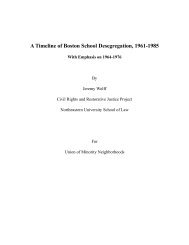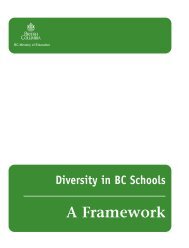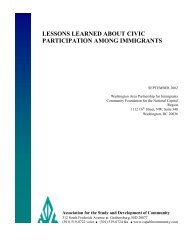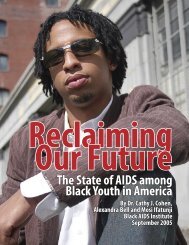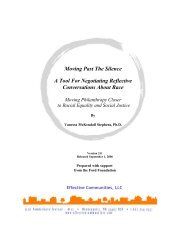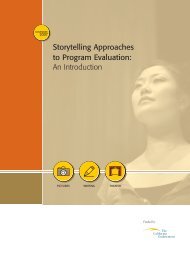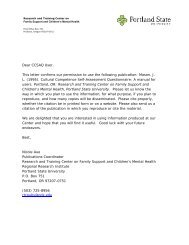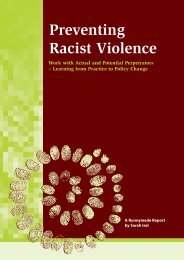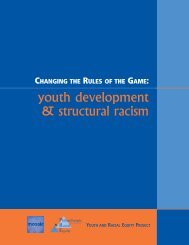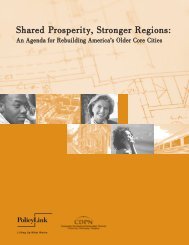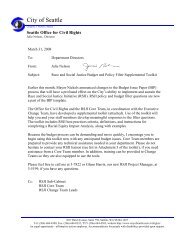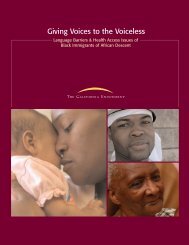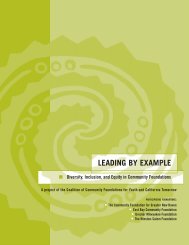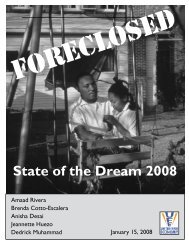PART IV:ConclusionAs Peter Bahouth, a founder <strong>of</strong> the Funders’Network <strong>and</strong> former executive director <strong>of</strong> theTurner Foundation, likes to say, “There is no hope,but we may be wrong.” The <strong>in</strong>novative strategiesillustrated by the stories <strong>in</strong> this report reveal that, <strong>in</strong>fact, we are wrong—there is hope. The complex yetvitally important issues addressed by theorganizations <strong>and</strong> foundations highlighted <strong>in</strong> thisreport are <strong>in</strong>spir<strong>in</strong>g, thought-provok<strong>in</strong>g, <strong>and</strong>excit<strong>in</strong>g. Hope lives.The projects <strong>in</strong> this publication were chosen todemonstrate how the comb<strong>in</strong>ation <strong>of</strong> advocacy,community organiz<strong>in</strong>g, <strong>and</strong> l<strong>and</strong> use developmentwork can help to achieve community <strong>and</strong> regionaltransformation. More <strong>and</strong> more, the Funders’Network is see<strong>in</strong>g traditional advocates for low<strong>in</strong>comecommunities <strong>and</strong> communities <strong>of</strong> colorbecome engaged <strong>in</strong> l<strong>and</strong> use issues by tak<strong>in</strong>gdevelopment tra<strong>in</strong><strong>in</strong>g courses or learn<strong>in</strong>g thelanguage <strong>of</strong> zon<strong>in</strong>g ord<strong>in</strong>ances. Advocates whoacknowledge development realities <strong>and</strong> can balancelegal, organiz<strong>in</strong>g, <strong>and</strong> legislative tactics are craft<strong>in</strong>gmore sound policies <strong>and</strong> hav<strong>in</strong>g greater impacts onthose they serve.Hav<strong>in</strong>g over 70 projects to choose from for<strong>in</strong>clusion <strong>in</strong> this report shows the <strong>in</strong>creas<strong>in</strong>gimportance <strong>and</strong> momentum <strong>of</strong> the movement forregional <strong>and</strong> neighborhood equity. The stories<strong>in</strong>clude many examples <strong>of</strong> the philanthropiccommunity capitaliz<strong>in</strong>g on its ability to be<strong>in</strong>novative, flexible, <strong>and</strong> use a longer-termperspective. Foundations are recogniz<strong>in</strong>g that oneyeargrants with multiple conditions <strong>of</strong>ten do notget the job done. The stories <strong>in</strong> this reportdemonstrate what can happen when philanthropyth<strong>in</strong>ks <strong>and</strong> acts differently <strong>in</strong> partnership withlead<strong>in</strong>g advocates, developers, academic <strong>in</strong>stitutions,<strong>and</strong> public sector leaders.These projects demonstrate an evolv<strong>in</strong>g frameworkregard<strong>in</strong>g equitable development strategies. Next, itis important for the framework to becomewidespread common knowledge, so that the promises<strong>of</strong> regional <strong>and</strong> neighborhood equity can be realizedon a larger scale.Foundations are recogniz<strong>in</strong>g the value <strong>of</strong> us<strong>in</strong>g anequitable development framework <strong>in</strong> theirgrantmak<strong>in</strong>g to help them th<strong>in</strong>k <strong>of</strong> new ways thattheir <strong>in</strong>dividual grants can have a broader impact. Byensur<strong>in</strong>g that grants help to <strong>in</strong>tegrate people- <strong>and</strong>place-focused strategies, reduce local <strong>and</strong> regionaldisparities, promote double bottom l<strong>in</strong>e <strong>in</strong>vestments,<strong>and</strong> ensure mean<strong>in</strong>gful community participation,foundations may see greater social <strong>and</strong> economicreturns on their <strong>in</strong>vestments.While the stories <strong>in</strong> this report <strong>in</strong>cludedescriptions <strong>of</strong> what foundations have done, theFunders’ Network hopes it will also serve as aguide for what still needs to be done, many moretimes <strong>in</strong> many more places. As each <strong>of</strong> these storiesillustrates, it is possible for a foundation tocontribute to smarter growth strategies that worktowards creat<strong>in</strong>g more equitable regions. Threeclear themes are revealed <strong>in</strong> this report that are<strong>in</strong>tegral to efforts to advance a framework forregional <strong>and</strong> neighborhood equity.1) The Region MattersEven funders focused on neighborhood quality <strong>of</strong> lifeunderst<strong>and</strong> that regional demographics—<strong>in</strong>clud<strong>in</strong>gtransportation <strong>in</strong>vestments, population growth <strong>and</strong>decl<strong>in</strong>e, etc.—are important to consider <strong>in</strong> order forgrantmak<strong>in</strong>g <strong>in</strong> neighborhoods to be effective. Thefoundations pr<strong>of</strong>iled <strong>in</strong> this report f<strong>in</strong>d that aregional lens is an important one to employ <strong>in</strong> theirgrantmak<strong>in</strong>g, even if they are only fund<strong>in</strong>g locally.Hav<strong>in</strong>g knowledge <strong>of</strong> the region helps to ensuremore targeted <strong>and</strong> potentially effective work on theneighborhood or local level.2) Public Policy is a Lever for ChangeMany grantmakers are f<strong>in</strong>d<strong>in</strong>g that they can furtherleverage their grant dollars by support<strong>in</strong>g policy work(such as CBAs, <strong>in</strong>clusionary zon<strong>in</strong>g policies,community organiz<strong>in</strong>g, etc.). Grants to buildaffordable hous<strong>in</strong>g are enhanced by policy work thatencourages a more receptive federal, state, or localpolicy framework (or f<strong>in</strong>ancial <strong>in</strong>vestment) forhous<strong>in</strong>g. Foundations have the legal right to supportvarious types <strong>of</strong> policy work. For more <strong>in</strong>formation,visit the Alliance for Justice’s Foundation AdvocacyProject (www.allianceforjustice.org) or the Center forLobby<strong>in</strong>g <strong>in</strong> the Public Interest (www.clpi.org).119 Funders’ Network for Smart Growth <strong>and</strong> Livable Communities
3) Issues Need to be ConnectedThe foundations <strong>and</strong> organizations pr<strong>of</strong>iled <strong>in</strong> thisreport recognize the connections among issues theycare about <strong>and</strong> the effects <strong>of</strong> l<strong>and</strong> use decisionmak<strong>in</strong>g.L<strong>and</strong> use policies <strong>and</strong> practices have implications onwork to alleviate poverty, ensure access to jobs <strong>and</strong>education, <strong>and</strong> encourage healthy, active lifestyles. Forexample, the movement <strong>of</strong> jobs to the suburbs requiresthat organizations pay attention to transportationaccess, so that potential employees can reachappropriate opportunities. By recogniz<strong>in</strong>g l<strong>in</strong>ks <strong>and</strong>connections between issues, the foundations pr<strong>of</strong>iledhere f<strong>in</strong>d that the means to accomplish the outcomesthey desire may change once they realize the underly<strong>in</strong>gfactors that affect the surface problem or challenge.Hav<strong>in</strong>g a strong impact requires a commitment <strong>of</strong>patience <strong>and</strong> time. Beyond the three broad themeshighlighted previously, the stories <strong>in</strong> this report alsoreveal a series <strong>of</strong> common general factors thatcontribute to the success <strong>of</strong> these projects from thefunder’s perspective. The follow<strong>in</strong>g recommendationsbuild on these success factors <strong>and</strong> are designed toencourage <strong>and</strong> <strong>in</strong>spire grantmakers <strong>in</strong> their work.Pay attention to race <strong>and</strong> class: Race <strong>and</strong> classissues need to be addressed at the forefront. Theregional <strong>and</strong> neighborhood equity framework is morereadily welcomed among low-<strong>in</strong>come communities<strong>and</strong> communities <strong>of</strong> color because it addresses race<strong>and</strong> class issues up front. The fundamentaldifferences between the movements for smartergrowth <strong>and</strong> regional equity have been their respectivehistories as well as the faces <strong>of</strong> those at the forefront.Advocates for a regional equity framework, such asCarl Anthony, Angela Blackwell, Manuel Pastor, <strong>and</strong>john powell, are people <strong>of</strong> color who have fought forcivil rights <strong>and</strong> social justice issues, especially as theyrelate to l<strong>and</strong> use decisions. In the 1990s, many <strong>of</strong>the conversations about regionalism were drivenfrom a smart growth perspective, but rarely did thesediscussions lead with race <strong>and</strong> equity. Today, due tothe efforts <strong>of</strong> lead<strong>in</strong>g socially-conscious advocates forsmarter growth, one sees <strong>in</strong>creas<strong>in</strong>g participation <strong>of</strong>people <strong>of</strong> color <strong>in</strong> the movement for smart growth.As a result, development <strong>and</strong> growth patterns areslowly, but surely, be<strong>in</strong>g viewed through a racial lens.Address<strong>in</strong>g issues <strong>of</strong> race <strong>and</strong> class is not easy, but thehard work pays <strong>of</strong>f when strong cross-cultural, crossissue,<strong>and</strong> cross-class coalitions are created.Use all the tools available: A diverse array <strong>of</strong> toolsare available for foundations to employ <strong>in</strong> theirwork. Beyond that <strong>of</strong> grantmaker, foundations canplay roles <strong>in</strong>clud<strong>in</strong>g convener, educator, advocate,<strong>and</strong> <strong>in</strong>itiator. The stories <strong>in</strong> this report highlightexamples <strong>of</strong> foundations that are us<strong>in</strong>g all <strong>of</strong> thetools available to them <strong>and</strong> all <strong>of</strong> the assets at theirdisposal. For <strong>in</strong>stance, <strong>in</strong> the story <strong>of</strong> theCenterEdge Project, although one <strong>of</strong> thefoundations was not able to fund the regionaldisparities research, it was able to fund thecommunity dialogues that were necessary to achievea broad-based coalition. Foundations can th<strong>in</strong>kbeyond a grant request <strong>and</strong> about how they canfurther the work. A foundation may not be able toenter a project <strong>in</strong> the <strong>in</strong>itial phases, but may get<strong>in</strong>volved more strategically at a later time to helpcarry the torch.Commit to long-term <strong>in</strong>vestment: The mostcommon lesson <strong>of</strong>fered <strong>in</strong> these stories is that longterm<strong>in</strong>vestment is needed <strong>in</strong> order to change longst<strong>and</strong><strong>in</strong>gdevelopment pr<strong>in</strong>ciples. Yet even smallamounts <strong>of</strong> money can make a big difference, as seenthrough these stories, if allocated strategically alongwith fact-f<strong>in</strong>d<strong>in</strong>g, conven<strong>in</strong>g, <strong>and</strong> leadership.Committ<strong>in</strong>g to the long-term also <strong>in</strong>creases theopportunity for organizations <strong>and</strong> foundations toevaluate outcomes. As these stories show, there is adifference between build<strong>in</strong>g houses <strong>and</strong><strong>in</strong>corporat<strong>in</strong>g residents <strong>in</strong>to the larger community.Although equally important, one requires a longerterm<strong>in</strong>vestment, yet may ultimately lead to theoutcomes desired by both the project <strong>and</strong> thegrantmaker.Partner with grantees <strong>and</strong> take risks: In each <strong>of</strong>the stories, one or more <strong>in</strong>dividuals—a program<strong>of</strong>ficer, CEO, or trustee—was will<strong>in</strong>g to lead afoundation to take a risk <strong>and</strong> th<strong>in</strong>k outside <strong>of</strong> thebox. In some cases, <strong>in</strong>spir<strong>in</strong>g board members <strong>and</strong>trustees by us<strong>in</strong>g conven<strong>in</strong>gs <strong>and</strong> site visits, helpedpush an agenda forward. In addition, these storiesrarely <strong>in</strong>volve reactive grantmak<strong>in</strong>g. Most <strong>of</strong> theseexamples <strong>in</strong>volve funders partner<strong>in</strong>g with grantees todevelop <strong>and</strong> implement strategies, go<strong>in</strong>g beyond thetypical arms-length relationships that characterizefunder/grantee <strong>in</strong>teraction.Tell stories: Shar<strong>in</strong>g <strong>in</strong>formation about what iswork<strong>in</strong>g represents a powerful source <strong>of</strong> ideas for thephilanthropic community. The Funders’ Network isbecom<strong>in</strong>g a repository <strong>of</strong> <strong>in</strong>formation aboutfoundation activity <strong>in</strong> this area. Visitwww.fundersnetwork.org for more <strong>in</strong>formation.Part IV: Conclusion120
- Page 1 and 2:
Stories of Philanthropic Leadership
- Page 3 and 4:
Signs of Promise:Stories of Philant
- Page 5 and 6:
Funders’ Network for Smart Growth
- Page 7 and 8:
(II. B.)(II. C.)Turning Neighborhoo
- Page 9 and 10:
PART I:IntroductionThe Purpose of t
- Page 11 and 12:
social justice issues as they relat
- Page 13 and 14:
PART II:Perspectives on Advancing R
- Page 15 and 16:
peer work, we can reestablish a sig
- Page 17 and 18:
Annie E. Casey FoundationBaltimore,
- Page 19 and 20:
neighborhoods into healthy ones—g
- Page 21 and 22:
Charles and Helen Schwab Foundation
- Page 23 and 24:
Section 1:Promoting Equitable Publi
- Page 25 and 26:
I. A. BUILDING POWER AND GIVINGVOIC
- Page 27 and 28:
policy advocates. In 2002, Milwauke
- Page 29 and 30:
in Los Angeles, Ford’s Anthony no
- Page 31 and 32:
I. B. PROMOTING COALITIONSTO ADVANC
- Page 33 and 34:
Yet the interpersonal dynamics of c
- Page 35 and 36:
guidelines. “Many of the member o
- Page 37 and 38:
Funder InterestThe EPA supported th
- Page 39 and 40:
I. D. DEMONSTRATING THESTRUGGLE FOR
- Page 41 and 42:
Richmond, Calif.The second regional
- Page 43 and 44:
through policy reform at the local
- Page 45 and 46:
I. E. BUILDING COALITIONTHROUGH KNO
- Page 47 and 48:
organizing project, the Connecticut
- Page 49 and 50:
and businesses are quantified in a
- Page 51 and 52:
I. G. REVITALIZING WHILEASSURING DI
- Page 53 and 54:
In the late 1990s, the city of Albu
- Page 55 and 56:
I. H. A TRAVEZ DE LA FRONTERA:LAND
- Page 57 and 58:
The International Community Foundat
- Page 59 and 60:
I. I. MOBILIZING ACTION FORREGIONAL
- Page 61 and 62:
To meet all of these objectives, th
- Page 63 and 64:
efforts. And with each public plann
- Page 65 and 66:
pattern of disproportionate transpo
- Page 67 and 68:
Clinica de la Raza identify this cr
- Page 69 and 70:
Contact PeopleCarl AnthonyActing Di
- Page 71 and 72:
Section 2:Making All Neighborhoods
- Page 73 and 74:
II. A. REACHING BEYONDHOUSING TO IM
- Page 75 and 76: A local resident receives the keys
- Page 77 and 78: East Baltimore community and the Jo
- Page 79 and 80: example, adjacent to the EBDI area,
- Page 81 and 82: II. C. YIELDING REGIONALBENEFITS TH
- Page 83 and 84: is using transit-oriented developme
- Page 85 and 86: financing and innovative, forward-t
- Page 87 and 88: The Row House Community Development
- Page 89 and 90: II. E. COUNTERING THE PERFECTSTORM:
- Page 91 and 92: funded community programs, includin
- Page 93 and 94: housing developments and commercial
- Page 95 and 96: owned enterprises, totaling $8.5 mi
- Page 97 and 98: LOAN GUARANTEESSection 3:Connecting
- Page 99 and 100: III. A. MAKING HOUSING ANOPPORTUNIT
- Page 101 and 102: A new report from the National Hous
- Page 103 and 104: The Straphangers Campaign was found
- Page 105 and 106: Funder InterestThe Straphangers Cam
- Page 107 and 108: or increase poverty. Whether direct
- Page 109 and 110: The Regional Plan Association then
- Page 111 and 112: multi-stakeholder effort composed o
- Page 113 and 114: director with LISC. No one set of s
- Page 115 and 116: 12 western Louisville neighborhoods
- Page 117 and 118: III. E. UNITING THREE STATESFOR ONE
- Page 119 and 120: increased their personal wealth by
- Page 121 and 122: summary evaluation of MSDI found th
- Page 123 and 124: method alone was strong enough to m
- Page 125: consistent body of work. The Counci
- Page 129 and 130: PART V:Glossary of TermsThe terms d
- Page 131 and 132: Regional and neighborhood equity. A
- Page 133 and 134: Tijuana River Reserve, California:h
- Page 135 and 136: Sargent Shriver National Center on
- Page 137: 1500 San Remo Avenue • Suite 249



